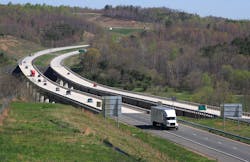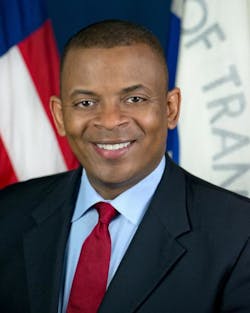Boosting funding and shaving costs associated with repairing roads and bridge, while better integrating modes to haul both people and freight are but a few components of a major transportation “vision” unveiled by Transportation Secretary Anthony Foxx yesterday in a luncheon speech at the 93rd annual Transportation Research Board meeting.
“In a room like this, you know the numbers,” Foxx said. “A third of all major roads are in ‘poor or mediocre condition’ [with] more than $86 billion in backlogged transit maintenance [and] 100,000 bridges old enough for Medicare.”
He is backing President Obama’s idea to fund transportation with the proceeds from corporate tax reform, which Foxx believes “is a good idea" because it could secure a source of transportation infrastructure funding for "multiple years."Yet Foxx (at right) also stressed that while funding is important, the nation is not going to be able to spend its way out of what he called the U.S. “infrastructure deficit.”
“Even if we replenish the Highway Trust Fund – and maybe add a little more to it – we would still have an infrastructure deficit,” he explained. “Generally speaking, a set amount of funding equals a set amount of projects: one plus one equals two. But what if we could make that funding equal more projects – and better ones? What if we could make one plus one equal three – or four?”
Foxx highlighted Utah’s I-15 highway extension effort as an example. “They had project-designers – the architects of the road, so to speak – and the builders work on-site together, which they hadn’t traditionally done before,” he said. “And because they did, they finished the project a full two years ahead of schedule and saved taxpayers $260 million. That $260 million was then put back into the pipeline to fund three more highway projects.”
Foxx also pointed to the potential cost savings associated with using what’s called “warm mix” asphalt as it doesn’t have to be heated as hot to pave roads. “That may not sound impressive, but the savings it generates do: It will save us $3.6 billion by 2020,” he explained.
That’s why Foxx said DOT is going to focus on finding more efficiencies going forward – implementing performance measures that reward projects completed under budget and ahead of schedule and remaking permitting processes so that, in the vast majority of cases, it takes days or weeks instead of months and years.
“Now, while stories like these don’t make the front page of the New York Times, this kind of [cost] efficiency is important because it creates more capacity,” he added.
Foxx also noted that DOT is working on developing what he called an “integrated transportation plan,” because the way the nation currently thinks about transportation is fractured.
“Highway people like highways, transit people like transit, rail people like rail, and so on,” he said. “But our transportation system should be greater than the sum of its parts.”
Foxx explained that if the U.S. is going to build a better system, “it must shape an integrated strategy for where we’re headed, not just where we’ve been,” he said.
“After all, that’s how people experience transportation. It’s all integrated. It’s all interconnected. They don’t only travel by car or train or ship or plane; they transition and transfer among all of them,” Foxx emphasized.
“Now, we are already making progress on this front, developing a National Freight Plan that looks at all modes. But we need to do more,” he stressed. “We need a plan that takes our roads and rails and ports and links them and remakes the finest system of transportation the world has ever known into its 21st-century incarnation. So crafting a new plan is going to take some work.”
And safety issues will remain an uppermost part of that plan, he stressed.
“I want to build on our safety record at DOT,” Foxx said. “Try as we might, accidents and tragedies continue to occur [and] we [at DOT] feel an urgency to prevent them from happening again, too. That said, though, I’m very proud that when you look at all the data, this is the safest time to travel in the history of traveling.”
Foxx noted that he remains “committed to keeping up that standard – and to do it by making sure distracted and drunk drivers are kept off the road – and that only safe, legal bus companies are kept on it,” but added that safety focus will also be applied more forcefully to energy transport activities as well.
“America is now the world’s leading energy producer, and we should be the world leader in safely transporting it, too,” he said. “We have to assure the American people that natural gas can be liquefied and moved without incident and that Bakken [shale] oil can move safely no matter how it’s transported.”
Foxx noted that DOT holding a meeting this week with the petroleum and rail industries to discuss safety issues related to the explosion last month of an oil-carry freight train in North Dakota. “We’ll be talking about exactly this issue: How we can ensure that, as our energy production increases, we’re working together to safely transport crude oil by rail,” he said.
About the Author
Sean Kilcarr
Editor in Chief
Sean Kilcarr is a former longtime FleetOwner senior editor who wrote for the publication from 2000 to 2018. He served as editor-in-chief from 2017 to 2018.

